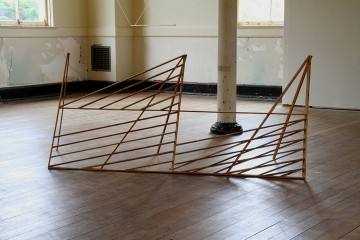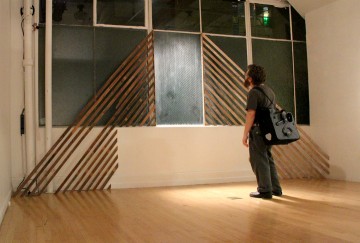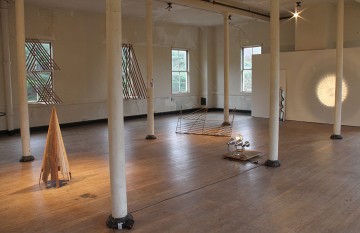Certain contemporary artists find so much to explore in one material that artist and medium become almost fused in the art-collective consciousness: think of Richard Serra and rolled steel, for example. San Francisco sculptor Andy Vogt has created, over the past decade or so, a series of wall-hung relief works, drawings, sculptures and now installations that exploit wooden lath, those rough-cut redwood strips, a quarter-inch by one and a quarter inches, that were found, coated with plaster, in every house, before the advent of the sheetrock era. Vogt scavenges the discarded old, worn sticks from dumpster bins and employs them to construct planar reliefs that suggest their origins. They read both as partial models of stick-frame houses with shattered roofs and splintered wall paneling, their beams and trusses dissolving as if corroded by space and light, and, with their exaggerated or collapsed perspectives, as sophisticated abstractions like the playful 2D/3D geometric paradoxes of Josef Albers and Al Held. Vogt’s lath works combine the dumpster and blueprint, the geological and the architectural, merging manmade and natural environments.

Andy Vogt. "Shade Shape," a door-sized lath lattice (or ladder) that derives from the shadows generated by Vogt’s Hayes Valley installation. The 3D/2D/3D creative hall of mirrors could, theoretically, continue forever.

Andy Vogt's "Central Pane" reprises the artist's Southern Exposure Gallery window piece on a smaller scale. Parallel lath stripes simulate the descent of light rays through the glass (and perhaps the cross-hatching used in drawing to create half-tones) but they also generate complex shadows on walls and floor.
Recent installations at Southern Exposure Gallery and Adobe Books, a public sculpture in the Hayes Valley area, and a residency at the Headlands Center for the Arts in rural Marin County west of the Golden Gate Bridge have expanded Vogt’s practice even further. Vogt detailed, in a discursive, object-based conversation we had recently at his Headlands studio, his new interest in how the environment inflects and affects the artwork, the changing sunlight transforming his sculptures into generators of complex but transient shadow “interference patterns” (which, photographed, become themselves the subjects of new artworks). Concurrent with this expanded area of investigation is his experimentation with new materials: lights, lenses, mirrors, dichroic glass and time-lapse digital photography. Vogt’s Headlands studio show (now ended) and his current show in the Project Room at Electric Works in San Francisco reveal his work in transition, headed toward a tripartite “second phase” comprising, probably—can art writers predict the future, like esthetic versions of Minority Report Pre-Cognitives?—immersive installations (possibly executed in more permanent materials than lath) enlisting sunlight as a “drawing element” and animation source; more use of digital photography and video to explore the mechanics of perception; and, for gallery work, an embrace of the new digital printing technology.





